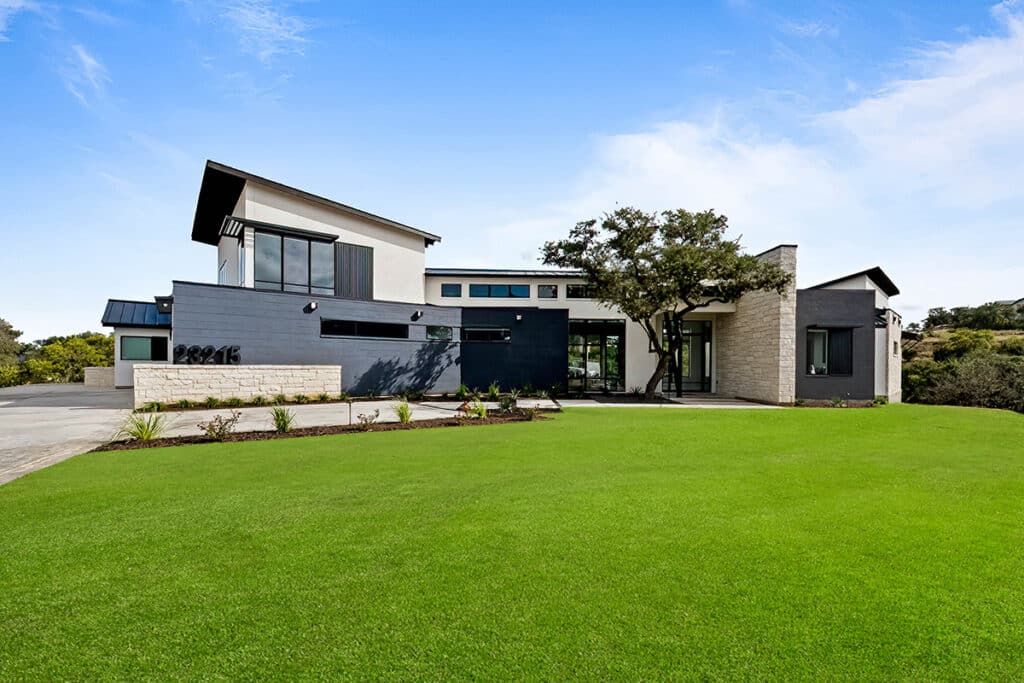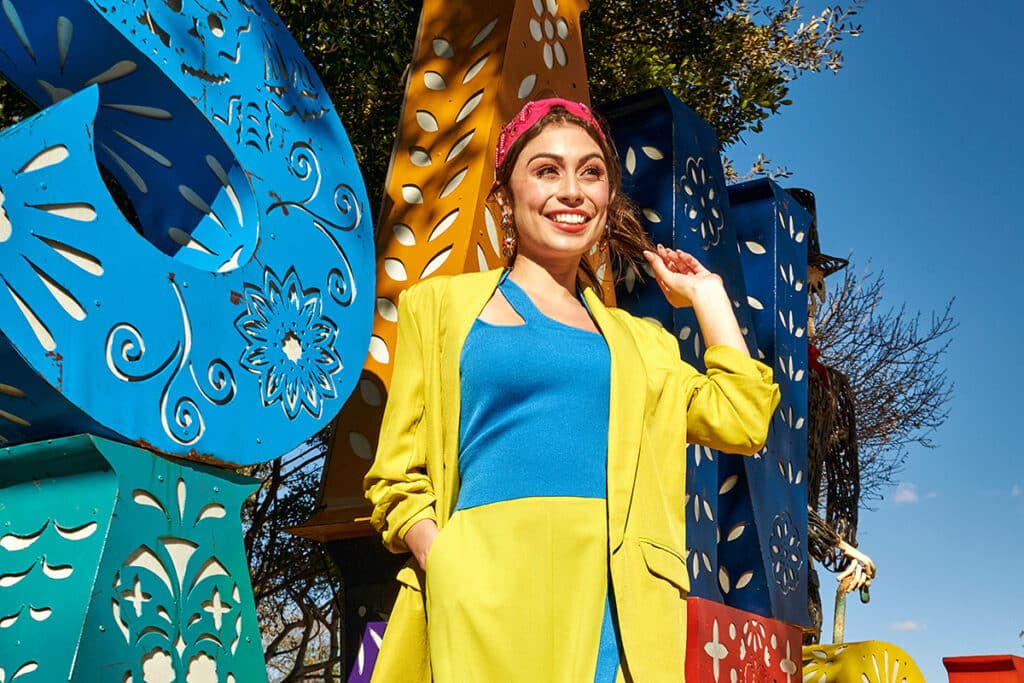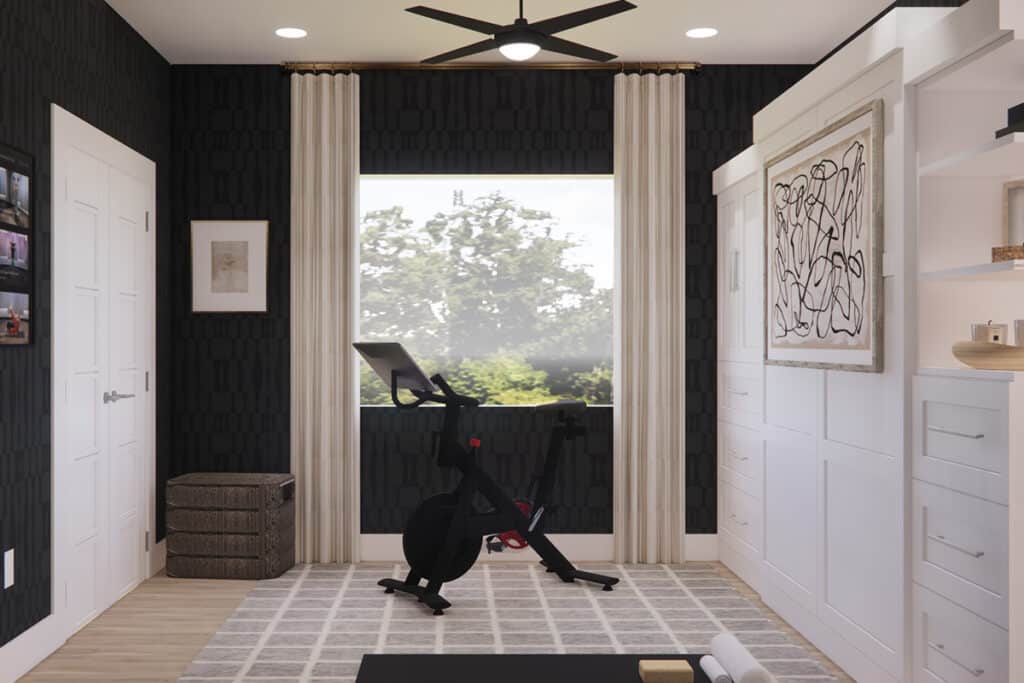The world is not black and white for Veronica Prida and Omar Rodríguez. Pulsing vibrantly with the colors of Mexican folk art, Mother Nature and personal exuberance, their Alamo Heights home displays the couple’s love of art, textiles and living. It’s like a constant casa fiesta. Once you cross their threshold, you’ll never look at four walls the same way again.
Artists in residence
It’s easy to see how the couple arrived at creating a home from a vivid palette; they are both celebrated artists. Veronica’s Prida Design Studio is home to her one-of-a-kind furniture designs, which reflect her interest in the huipil, the indigenous dress of southern Mexico and Central America. Her clothing designs are worn by women all over the world. For six months of the year, she is hard at work designing and embellishing the magnificent robes, gowns and crowns for Fiesta royalty. She heads a team of seamstresses who produce the couture that helps make Fiesta famous. Omar is a health care executive who never had formal art training. As a child, he never used any medium beyond a crayon or a marker “to color outside the lines” and then picked up a paintbrush in the middle of life and became an overnight sensation. Rodríguez is collected internationally; his paintings are exhibited in private, corporate and academic collections. His work was featured in Naomi Shihab Nye’s book Is This Forever or What? His portraiture was shown in the 2006 Ford and Smithsonian exhibition of Retratos: 2000 Years of Latin American Portraits at the San Antonio Museum of Art. He has 10 large-scale abstracts in the University of Texas system’s permanent collection.
The two are passionate supporters of local artists.
Happy accident
The couple discovered the home by accident 14 years ago. They were driving to a friend’s house when they saw the “For Sale” sign in front of this home.
“We thought it was unique, but we weren’t looking for a house,” Veronica says. “We were already in a home we loved. We talked about buying the place over coffee, and suddenly, two hours later, we made an offer and had a contract on it.” At that point, the house was one level. The home had been made into a duplex with a chopped-up floor plan and two entrances. With help from architect Kathryn Nored and contractor David Hartman, the couple gutted the home. Over the next year, they transformed the shell into a three-bedroom, two-bath home with an open floor plan more suitable for their relaxed lifestyle. The interior walls and wooden floors are painted in the vibrant hues of Mexican folk art to reflect their love of the art form. The same colors appear in much of Omar’s art, hung throughout the home. The eclectic furnishings are international in origin. “We brought some of our furniture from the condo we’d lived in; we bought a number of new pieces,” Omar recalls. “Some came from Nomads, others we found in Mexico. In our travels, we pick up things that will augment the furnishings we have.”
Dramatic entry
The large periwinkle-colored front doors from France are made of wood and glass; natural light filters in to accent the art displayed in the foyer. On one wall is Omar’s abstract portrait of Veronica — “one of his earliest works,” she says. “He just picked up pastels and this is what came out.” The hand-painted chest is from Afghanistan; Veronica indicates how similar the motifs are to those of Mexico. The pottery candle-holders displayed on the chest are from Michoacan. In the nicho beside the chest is a Christ figure from Guatemala. Tucked into a corner is an old wooden hobbyhorse that once belonged to Omar’s godson.
A tall screen from India is poised by the entry leading from the foyer into the living room; it is decorative as well as practical. “It’s easy to look straight into our home from outside the front doors,” Omar says. “More than once we’ve looked up from seating in our living room to see people peering in at us, wondering if this is a home or a shop. So the screen serves as a partition between the two rooms, shielding us from curious eyes.” The living area has a soaring two-story ceiling with windows near the top that admit natural light. Paintings are hung everywhere, but the room’s initial impact comes from the unusual open staircase with railings made of copper tubing. “We literally designed that staircase on a paper tablecloth at the Liberty Bar,” Omar says. “We had it made in Mexico and shipped here for installation. I guarantee there’s not another like it anywhere!”
Tucked beneath the stairs is a Moroccan bed that looks like an oversized chaise longue. Colorful pillows are strewn across the surface. An upholstered ottoman, placed in front of the bed and between two chairs, doubles as seating or as a table. The small table behind the seating is a family piece from Italy, where Omar lived as a teenager. Its surface is made entirely of inlaid stone so intricate that it looks like a painting. Behind this treasure is another table made of an old window from India, which is now protected with a surface of glass. At the far end of the room are tall double doors opening onto a patio. These doors came from Monterrey in the back of the couple’s Jeep Cherokee. “Several hundred miles we traveled with those doors wedged into that Jeep,” Omar recalls. “Veronica was stuffed into the seat next to me — I couldn’t even see her. Every so often I’d call out, ‘Are you still there?’ and she’d shout back to me. It was quite an adventure!” Many of the furnishings in the house are repurposed; the heavy dining table was made of Norwegian flooring. The chairs are dressed with colorfully embroidered Mexican huipiles. The three light fixtures illuminating the dining area are of punched tin from San Miguel in Mexico. The wine bar is an armoire made of Vietnamese bamboo.
Across the room, framing a large window, are ceiling-height cabinets faced with decorative tin salvaged from the ceilings of old houses. The rustic wrought iron candelabrum on the window casing, made by Texas artist Jan Barboglio, reflects the room’s rustic décor. The galley kitchen is separated from the dining area by a waist-high counter, allowing the cooks to easily converse with diners. The kitchen backsplash is of Spanish tile. Decorative masks from Guatemala adorn the walls; the pottery atop the cabinets is from Mexico. The ethnic accents and functional design make the kitchen a fun gathering place for the Prida-Rodríguez family. The wooden floor in the master suite is painted red; the room’s focal point is the king-sized bed, dressed in luxurious coverings from Peru, Guatemala and Mexico. The headboard was originally a carved doorway from Indonesia; it is surrounded by religious artworks, some of which are family heirlooms. A peek into the master bath reveals a roomful of tile Omar set himself. “I couldn’t find a tile contractor who understood that these small tiles didn’t have to be laid perfectly straight,” he says. “So I decided to do the job myself.” Ultimately the couple did much of the finish work in the house.
The wooden floor on the upstairs landing is painted blue; the material was recycled from a home being demolished in northern Mexico. The linen cabinet hides behind a louvered door, over which Veronica displays several multicolored members of her hand-woven belt collection. To the left of the landing is the guest room, complete with its own patio. “We often have coffee or after-dinner drinks up here,” Veronica says. “Sometimes when we have a party, we’ll put the bar up here so people can relax and enjoy the view. There’s usually a breeze up here because this is one of the highest points in Alamo Heights.”
Veronica uses the second bedroom as her office. Several of her furniture pieces are on display here, though they don’t always hang around the house long.
“My friends come over to visit, and sometimes they find a piece of furniture they can’t live without,” she says. “So I sell it to them and make something else to take its place. I can’t hang onto everything I make, although sometimes I’d like to. These are pieces of art that should be enjoyed by lots of people, so they need to go out into the world.”
Curating the collection
The Prida-Rodríguez home art gallery is not static; new pieces are added as new talent is discovered. Looking at the frame-filled walls, one wonders where a new piece would fit. “We move the pictures around often to accommodate new pieces,” Veronica says. “It’s like an art gallery. Sometimes you get a new take on an artwork when it is hung in a different place with different lighting.”
Colorful casa de celebracíon
Surprisingly, the couple rarely use their home for business entertaining. Instead, the colorful home is used for family occasions. “We do a lot of celebration stuff,” Omar says with a grin. “Our gatherings here are about friends, family and fellow artists.”




